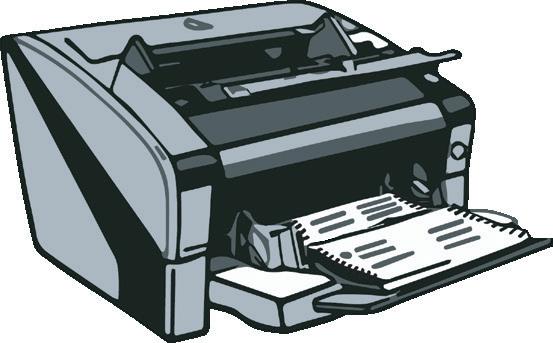
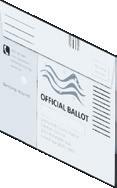
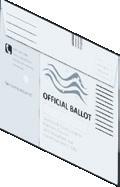
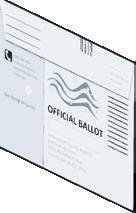
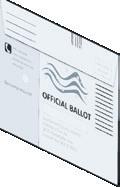
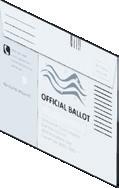
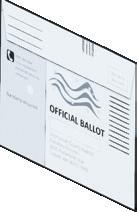
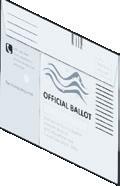
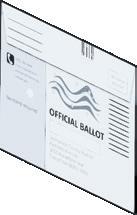
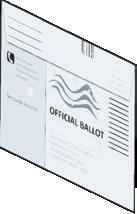
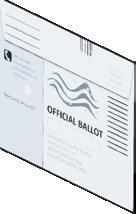
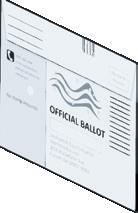
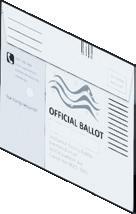
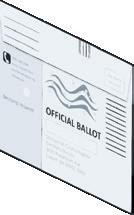
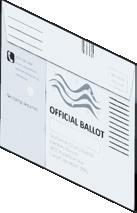
















Second Pass - “Accepted”














Staff scan unopened ballot envelopes twice using ballot sorting machines.
During the first pass, staff scan ballot envelopes, capturing the unique ballot envelope ID and an image of the signature.
Staff upload this information to the State voter registration system where voters’ ballots are marked “received” and envelope signatures are saved for comparison to voter registration records.
The second pass happens after staff have compared voters’ envelope signatures to their voter registration records. Ballot envelopes with matched and “accepted” signatures are sorted into batches and placed in green trays indicating they are ready for opening.

Staff specially trained to identify handwriting similarities and differences compare voters’ signatures on ballot envelopes to the signatures in their voter registration records to make sure they match.
If a signature on a ballot envelope does not match the signature in a voter’s registration record, staff flag the envelope.
Then staff contact the voter by mail, and when possible, email, text, and phone, with instructions on how to resolve the issue.

Staff open and inspect ballots in batches to maintain the secrecy of voters’ choices.
After checking out a batch from our tracking system, staff remove the secrecy sleeves containing voted ballots from the return envelopes.
Once all the secrecy sleeves have been removed, staff set the return envelopes aside. This step breaks the connection between voters’ identities and their ballots.
Next, staff remove the voted ballots from their secrecy sleeves.

Next, staff unfold and visually inspect ballots for voter corrections, damage, or unclear voter marks. Damaged ballots or those with voter corrections or unclear voter marks are placed at the top of the batch of ballots.
Finally, staff put the ballots into a ballot box and place the box on a cart, indicating the batch is ready to be scanned into the vote counting system.

Staff retrieve a batch of ballots that are ready to be scanned into the vote counting system. Each batch of ballots has corresponding paperwork indicating the number of ballots to be scanned.
After a batch of ballots is scanned, staff confirm that the correct number of ballots was scanned. Any discrepancies are investigated.
Staff place scanned ballots back into the ballot box and the box is sealed.
Two staff members are needed to access the secure cage where ballot scanning, ballot review, and tabulation occur. The ballot scanning equipment is never connected to the internet or external networks. It captures images of the ballots and does not count any votes until two staff tabulate initial election results at 8 p.m. on Election Night.

Staff retrieve a batch of ballots that contain ballots needing review.
Working in teams of two, staff review and address scanned ballot images with voter corrections, damage, or marks needing manual intervention to ensure accurate counting by the vote counting system. They follow the Voter Intent manual produced by the Washington Secretary of State and established in Washington Administrative Code. This practice ensures consistent interpretation of voter marks by elections staff within the county and across the State.
Staff complete paperwork for reconciliation and auditing purposes.

Tabulation of initial election results requires two staff members and happens no sooner than 8 p.m. on Election Night.
Because the ballot scanning and vote counting equipment is never connected to the internet, staff use a verified-clean USB drive to transfer results from the vote counting system to the state and county websites. USB drives are used only once and never reconnected to the vote counting system.
Staff process remaining ballots daily, and regularly release updated election results until the election is certified 10 to 21 days after Election Day.
The vote counting system cage has restricted access, is monitored by security cameras, and is secured with tamper-evident seals during nonwork periods.

After Election Day, staff conduct audits to confirm the accuracy of the ballot counting equipment and election results.
The first audit is called a random batch audit. Trained staff hand count randomly selected batches of ballots and compare the results to the ballot counting equipment totals.
The second audit is called a risk-limiting audit. Voted, counted ballots are selected at random and the votes on those ballots are examined to ensure they match what the machine counted.
Ballot counting equipment is also tested before every election. In the logic and accuracy test, election officials scan marked test ballots with a known outcome and make sure the counting equipment’s results are the same.

Staff secure ballots when not actively being processed in sealed containers and/or rooms with limited access, using tamper evident seals and logs.
Staff only access ballots for official processing, reconciliation, auditing, and recounting purposes, or if there’s a court order.
Ballots, signature envelopes, and accounting and reporting materials are maintained during and after the election according to state and federal retention periods.

Observers must sign in and out. Name tags and badges will be provided by Snohomish County Elections and must be visible at all times.
The Elections Center is designed with a dedicated observer corridor for clear viewing of activities. Observers require an invitation and authorized escort for spaces beyond the observer corridor.
Staff are busy working on important election activities. To limit disruption, questions shall be directed to the:
County Auditor, Chief Deputy Auditor, Elections Manager, Elections Supervisor, Elections and Voter Outreach Specialist, or designated leads.
Observers must not touch ballot envelopes, ballots, machinery, equipment, supplies, doors, etcetera. To maintain a clean facility and minimize maintenance costs, we also ask that observers do not touch windows or walls.
Observers may not bring food or drink beyond the lobby.
Examples of disruptive behavior include but are not limited to: distracting staff, obstructing the path of staff, making loud noises or comments, talking to non-designated staff, or wearing campaign items while observing. If, at any time, the conduct of observers becomes disruptive, authorized personnel may require that person to cease the disruptive activity or to leave.
The use of cell phones, digital recorders, cameras or any other communication or recording device in the Elections Center is prohibited. Cell phones and electronic devices must be silenced prior to entering the facility.
Observers may not make any record of the names, addresses, or other information on ballot return envelopes, ballots, or other ballot materials.
If any observer or visitor cannot follow the above rules or additional requests by designated employees, they will be directed out of the facility. Thank you for taking the time to observe our elections process!
